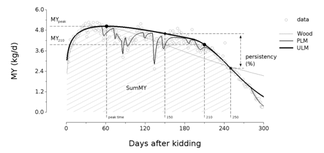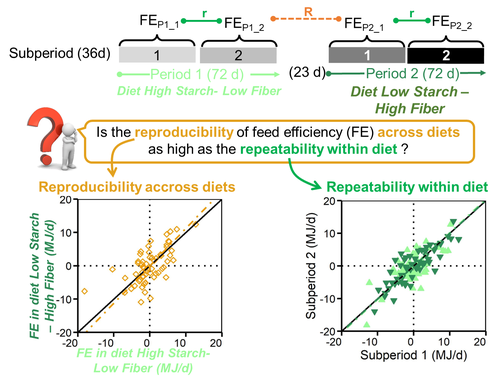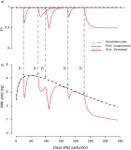
ATZORI Alberto
- Department of Agriculture, University of Sassari , Sassari, Italy
- Agricultural sustainability, Animal nutrition modelling, Cattle production, Mathematical modelling, Ruminant nutrition, Small ruminants
- recommender
Recommendations: 2
Reviews: 2
Recommendations: 2

Diversity of performance patterns in dairy goats: multi-scale analysis of the lactation curves of milk yield, body condition score and body weight
Understanding milk and body reserves trajectories and nutrient partitioning in dairy goats through a modelling approach
Recommended by Alberto Atzori based on reviews by Kristan Reed and 2 anonymous reviewersThe dairy sector is facing an historical period of high milk demand. However, increasing feed prices continually reduces the economic margins for farms. Managerial strategies to increase economical and technical awareness of animal performance, support the decision chain and optimize the use of production inputs are increasingly necessary, especially in goat farms with intensive production systems. Among the scientific goals, there is a particular emphasis on increasing knowledge about nutrition partitioning between milk production and body reserves — a topic that not easily addressed by nutritional models, limiting the attempts at production forecasting.
The paper by Gafsi et al (2024) presents an interesting approach to studying phenotypic traits and trajectories of goat performance. It assesses the diversity of phenotypic trajectories reflecting functions such as milk production, body weight and condition score. This approaches aims to describe, understand and explore the interactions among biological functions and potential trade-offs of phenotypic trajectories across current and successive lactations. The work significantly contributes to the literature, particularly because previous descriptions of lactation curves relied primarily on mathematical outputs lacking information about the relationship among physiologically related variables.
The analysis retrieved data from about 1500 goats over more than 20 years and was conducted with a multiscale approach. Data were fitted considering different types of models, including description of perturbations for lactation curves and with multiphasic models for the body weight and body condition score. Synthetic indicators were then estimated with a multivariate approach to define fitted trajectories and changes in performance.
The association among performance directly refers to nutrient partitioning, and the adaptive response of individual animals refers to nutrient availability and their aptitude to direct the metabolic effort toward milk production. In fact, the research shows that trajectories from the first lactation were often maintained in sequent ones. Positive associations among milk curve perturbations and the individual aptitude to drive nutrients to body reserves were also observed.
The multiscale approach developed in the paper may provide original insights both for describing animal performance and for ranking individual animals within farm groups. Practically, the method could inform the development of algorithms to support culling policies and individual animal assessments. Additionally, the data are available to the scientific community for further research and applications.
I recommend this paper as a methodological example with high replicable approaches for both goats and other dairy species, with significant applicative opportunities at the farm level.
Reference
Gafsi N, Martin O, Bidan F, Grimard B, Puillet L (2024) Diversity of performance patterns in dairy goats: multi-scale analysis of the lactation curves of milk yield, body condition score and body weight. Zenodo. 10101318. ver.3 peer-reviewed and recommended by Peer Community In Animal Science. https://doi.org/10.5281/zenodo.10101318

Feed efficiency of lactating Holstein cows was not as repeatable across diets as within diet over subsequent lactation stages
A focus on feed efficiency reproducibility and repeatability of dairy cows fed different diets over the lactation stage.
Recommended by Alberto Atzori based on reviews by Ioannis Kaimakamis, Angela Schwarm and 2 anonymous reviewersThe topic of feed efficiency is under discussion in the scientific community and several studies pointed out that lactation stage has to be accounted for when estimates of feed efficiency are carried out, especially for genetic ranking of animals and their performances, as highlighted by Li et al. (2017). Other researchers applied a latin square design to test dietary effects across lactation (Ipharraguerre et al. 2002) but this approach cannot be followed out of experimental conditions and particularly does not allow, nowadays, to valorize precision livestock farm data to get phenotypic information from individual animals at farm level.
The current manuscript by Fischer, et al. (2022a) describes an experimental trial in which cows were first fed a high starch diet-low fibre then switched over to a low starch diet-high fibre and individually monitored over time. Data were analyzed with the objective to investigate effects within diets and across diets. Since all cows went through the same sequence at the same time it was not possible to completely separate the confounding effect of lactation stage and diet as stated by the authors. However, this manuscript adds methodological discussions and opens research questions especially to the matter of repeatability and reproducibility of feed efficiency of individual animals over the lactation stage. These variables are fundamental to evaluate nutritional traits and phenotypic performances of dairy cows at farm level, as highlighted by a paper of the same first author (Fischer, et al. 2022b) dealing to reproducibility and repeatability with a similar approach. My opinion is that this manuscript gives the opportunity to enlarge the scientific discussions on the calculation of repeatability and reproducibility of feed efficiency of individual animals over time. In particular, as in this study, specific mathematical approaches need to be carried out with the final goal to analyze and valorize precision livestock farm data for cow phenotyping and to propose new methods of feed efficiency evaluations. It also needs complete databases carried out under experimental conditions. In fact it has to be considered that this manuscript makes available to the scientific community all the data and the R code developed for data analysis giving the opportunity to replicate the calculations and propose new advancements in the feed efficiency evaluations of dairy cows.
References
Fischer A, Gasnier P, Faverdin P (2022a) Feed efficiency of lactating Holstein cows was not as repeatable across diets as within diet over subsequent lactation stages. bioRxiv, 2021.02.10.430560, ver. 3 peer-reviewed and recommended by Peer Community in Animal Science. https://doi.org/10.1101/2021.02.10.430560
Fischer A, Dai X, Kalscheur KF (2022b) Feed efficiency of lactating Holstein cows is repeatable within diet but less reproducible when changing dietary starch and forage concentrations. animal, 16, 100599. https://doi.org/10.1016/J.ANIMAL.2022.100599
Ipharraguerre IR, Ipharraguerre RR, Clark JH (2002) Performance of Lactating Dairy Cows Fed Varying Amounts of Soyhulls as a Replacement for Corn Grain. Journal of Dairy Science, 85, 2905–2912. https://doi.org/10.3168/JDS.S0022-0302(02)74378-6
Li B, Berglund B, Fikse WF, Lassen J, Lidauer MH, Mäntysaari P, Løvendahl P (2017) Neglect of lactation stage leads to naive assessment of residual feed intake in dairy cattle. Journal of Dairy Science, 100, 9076–9084. https://doi.org/10.3168/JDS.2017-12775
Reviews: 2

Modelling the impact of the macroalgae Asparagopsis taxiformis on rumen microbial fermentation and methane production
Understanding the mechanisms behind natural bioactive compounds that can potentially reduce methane production in anaerobic conditions. A case study of Asparagopsis taxiformis
Recommended by Luis Tedeschi based on reviews by Alberto Atzori, Henk van Lingen and 2 anonymous reviewersNaturally occurring compounds that can reduce methane production in anaerobic conditions have been studied for quite some time as feasible approaches to mitigate methane production in ruminant animals, especially those of commercial importance. Asparagopsis taxiformis (red algae) and Dictyota bartayresii (brown algae) are effective inhibitors of methane synthesis under in vitro anaerobic fermentation systems (Machado et al., 2014) likely because of their high concentration of secondary metabolites that are toxic to the typical rumen microbiota, including protozoa. In addition to phytoplankton (Palmer and Reason, 2009), Asparagopsis contains a high concentration of haloform compounds (e.g., bromoform, chloroform) while Dictyota has a high concentration of isoprenoid terpenes. Despite the economic and biological impact of diverse phytochemicals on reducing methane production in ruminant animals (Tedeschi et al., 2021), haloform compounds’ environmental impact and safety, in particular, are still unclear. In the present study, Munõz-Tamayo and collaborators (2021) listed relevant literature about the impact of A. taxiformis on ruminal methane production.
Concurrent to the understanding of mechanisms and biology behind the reduction of ruminal methane, mathematical models can lead the way to enhance the effectiveness of feeding A. taxiformis under commercial applications. Thus, in the present study, Munõz-Tamayo and collaborators (2021) sought to develop a mathematical model to understand the rumen fermentation changes in vitro experimentation containing extract of A. taxiformis by adapting a previously documented model by Muñoz-Tamayo et al. (2016).
Modeling development, calibration, and evaluation steps should be independent of each other, requiring complete, distinct, and separate databases (Tedeschi, 2006). However, in rare circumstances where such requirements cannot be met because data availability is scarce, the cross-validation technique, when possible, should be considered to assess data dispersion’s effects on model adequacy. In other situations, clear reasoning for failing to do so must be addressed in the paper. In the present paper, Munõz-Tamayo and collaborators (2021) explained the limitations in their modeling efforts were primarily due to the lack of ideal data: “experiments with simultaneous dynamic data of bromoform, volatile fatty acids, hydrogen, and methane.” Regardless of the availability of ideal data, improvements in the conceptual model are warranted to include amino acids and branched-chain fatty acids fermentation dynamics in the rumen and the fluctuations in ruminal pH.
References
Machado L, Magnusson M, Paul NA, Nys R de, Tomkins N (2014) Effects of Marine and Freshwater Macroalgae on In Vitro Total Gas and Methane Production. PLOS ONE, 9, e85289. https://doi.org/10.1371/journal.pone.0085289
Muñoz-Tamayo R, Chagas JC, Ramin M, Krizsan SJ (2021) Modelling the impact of the macroalgae Asparagopsis taxiformis on rumen microbial fermentation and methane production. bioRxiv, 2020.11.09.374330, ver. 4 peer-reviewed and recommended by PCI Animal Science. https://doi.org/10.1101/2020.11.09.374330
Muñoz-Tamayo R, Giger-Reverdin S, Sauvant D (2016) Mechanistic modelling of in vitro fermentation and methane production by rumen microbiota. Animal Feed Science and Technology, 220, 1–21. https://doi.org/10.1016/j.anifeedsci.2016.07.005
Palmer CJ, Reason CJ (2009) Relationships of surface bromoform concentrations with mixed layer depth and salinity in the tropical oceans. Global Biogeochemical Cycles, 23. https://doi.org/10.1029/2008GB003338
Tedeschi LO (2006) Assessment of the adequacy of mathematical models. Agricultural Systems, 89, 225–247. https://doi.org/10.1016/j.agsy.2005.11.004
Tedeschi LO, Muir JP, Naumann HD, Norris AB, Ramírez-Restrepo CA, Mertens-Talcott SU (2021) Nutritional Aspects of Ecologically Relevant Phytochemicals in Ruminant Production. Frontiers in Veterinary Science, 8. https://doi.org/10.3389/fvets.2021.628445

Lactation curve model with explicit representation of perturbations as a phenotyping tool for dairy livestock precision farming.
Developing smart fitting algorithms to identify random perturbations in time-series data
Recommended by Luis Tedeschi based on reviews by Alberto Atzori, Jennifer Spencer and 1 anonymous reviewerThe ability to adequately characterize the lactation curve of livestock is important not only to ensure proper nutrition of the lactating animal but, among many other benefits, it can assist in diagnosing the incidence of diseases, predicting the quantity of milk production, and comparing animals within the herd for managerial strategies such as culling. Eventually, such smart fitting algorithms can lead to improved genetic selection of more productive animals after genetic-unrelated noises are removed from the data, systematically.
The manuscript by Ben Abdelkrim et al. developed and explained an algorithm to detect perturbations in lactation curves of dairy goats. Researchers have been interested in accurately describing lactation curves since the early-1960s. Johansson [1] proposed a nonlinear decay function, Nelder [2] described an inverse polynomial, and Wood [3] proposed the incomplete gamma function to describe milk production of dairy cows. Unfortunately, many of the lactating animals that yielded lactation curves that did not comply with the typical, expected pattern of milk production were usually discarded and, until then, efforts to address this lack of adherence were not conducted. The recommended manuscript provides a different perspective in which rather than discarding the lactation profile, one can model the perturbations of the lactation curve as an attempt to identify possible problems (e.g., mastitis) and minimize their occurrence. Such an algorithm is important to separate females that show resilient attributes from those females that show sustainable attributes, as per existing definitions proposed by Tedeschi et al. [4].
The recommended manuscript proposes the Perturbed Lactation Model to explicitly account for multiple perturbations in the time-series milk production in dairy goats. When perturbations occur in biological processes, a typical negative impact is observed in the animal’s response, but on rare occasions, positive impacts can occur. In this case, the animal responds positively to the perturbation (i.e., responsive), and as a result, there is an increase in their output when compared to unperturbed animals. The recommended manuscript only considered negative impacts due to perturbations in the lactation curve of dairy goats. Future modifications should include positive responses due to perturbations. In this case, animals would be “positively responsive” to perturbations, and examples of such behavior include feed intake and growth curves.
References
[1] Johansson, I. (1961). Genetic Aspects of Dairy Cattle Breeding. University of Illinois Press, Urbana, IL.
[2] Nelder, J. A. (1966). Inverse polynomials, a useful group of multi-factor response functions. Biometrics. 22 (1):128-141. doi: 10.2307/2528220
[3] Wood, P. D. P. (1967). Algebraic model of the lactation curve in cattle. Nature. 216 (5111):164-165. doi: 10.1038/216164a0
[4] Tedeschi, L. O., J. P. Muir, D. G. Riley, and D. G. Fox. (2015). The role of ruminant animals in sustainable livestock intensification programs. Int. J. Sustainable Dev. World Ecol. 22 (5):452-465. doi: 10.1080/13504509.2015.1075441